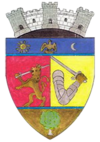Sângeorgiu de Pădure
|
Sângeorgiu de Pădure Erdőszentgyörgy |
||
|---|---|---|
| Town | ||

Landscape near the town
|
||
|
||
 |
||
| Coordinates: 46°25′49″N 24°50′30″E / 46.43028°N 24.84167°E | ||
| Country |
|
|
| County | Mureș County | |
| Status | Town | |
| Government | ||
| • Mayor | András Tar (Democratic Union of Hungarians in Romania) | |
| Area | ||
| • Total | 71,42 km2 (2,758 sq mi) | |
| Population (2002) | ||
| • Total | 5,492 | |
| • Density | 78/km2 (200/sq mi) | |
| Time zone | EET (UTC+2) | |
| • Summer (DST) | EEST (UTC+3) | |
| Postal Code | 547535 | |
| Area code(s) | +40 265 | |
| Website | Mayor's Office website | |
Sângeorgiu de Pădure (Hungarian: Erdőszentgyörgy, pronounced [ˈɛrdøːsɛnɟørɟ], meaning "St. George of the Forest"; German: Sankt Georgen auf der Heide) is a town in Mureș County, Romania.
Bezid (Bözöd), Bezidu Nou (Bözödújfalu) and Loțu (Lóc) villages are administratively part of the town.
The first written record of the town is preserved in a papal tithe applotment list from 1333 in which mention is made of a priest „de Sancto Georgio” who paid a sum of 6 dinars to the neighboring diocese. In 1347, a man named Erdő, count of the Székelys, and the sons of Erdő of Erdőszentgyörgy were mentioned. In 1442, Anna Herepei, wife of Erdő of Erdewzenthgergh is written about. The village was the estate of Francis I Rákóczi, prince of Transylvania. The Rédey castle was built in 1647. In 1788, Péter Bodor was born here. In 1818-1809, the Rédey castle was rebuilt. In 1913, the official Hungarian name of the village is Erdőszentgyörgy.
Its Romanian name was originally Erdeo-Sângeorgiu, after 1919 Sîngeorgiul de Pădure which later was changed by Romanian authorities to the current official name.
In the mid-1780s as part of the Josephine administrative reform, Marosszék was integrated into Küküllő county, however, the szék-system was restored in 1790. After the suppression of the Hungarian Revolution in 1849, the village formed part of the Kibéd military sub-division of the Marosvásárhely division in the Udvarhely military district. Between 1861–1876, the former Marosszék was restored. As a result of the administrative reform in 1876, the village fell within Nyárádszereda district of Maros-Torda County in the Kingdom of Hungary. After the Treaty of Trianon of 1920, it became part of Romania and fell within Mureș-Turda County during the interwar period. In 1940, the Second Vienna Award granted the Northern Transylvania to Hungary and it was held by Hungary until 1944. Administered by the Soviet authorities after 12 November 1944, the village, together with the rest of Northern Transylvania, came under Romanian administration on 13 March 1945 and became officially part of Romania in 1947. Between 1952 and 1960, the commune fell within the Magyar Autonomous Region, between 1960 and 1968 the Mureș-Magyar Autonomous Region. In 1968, the province was abolished, and since then, the settlement has been part of Mureș County. It became a town in 2004.
...
Wikipedia


